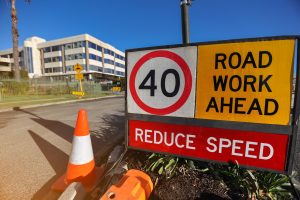Print a Sign-In Sheet | Spanish Version Coming Soon
Motor vehicle accidents account for several serious and fatal injuries in the United States each year. Work zones present safety hazards to workers in the area, and one of the major concerns is the risk of an employee being struck by traffic. Some of the categories of workers most at risk include emergency responders, clean-up crews, utility crews, demolition workers, and construction workers. Work zones are used to move traffic in a safe and approved direction of travel. Work Zones should be clearly marked with signs, cones, barrels, and/or barriers. Please see below for tips to keep workers safe.
- Develop a traffic control plan.
- Ensure drivers, workers, and pedestrians can see and understand the routes.
- Follow the authority in charge.
- Federal, state, or local authorities determine the configuration for motorists and pedestrians.
- Construction project managers determine the internal traffic control plan within the construction/demolition worksite.
- Post signage.
- Speed limits.
- Work zones.
- Information to assist drivers in identifying designated traffic paths:
- EVACUATION ROUTE.
- DO NOT ENTER.
- REDUCED SPEED AHEAD.
- ROAD CLOSED.
- NO OUTLET.
- Place traffic control devices (authority in charge determines the approved devices).
- Traffic signals.
- Message boards.
- Cones.
- Barrels.
- Barricades/barriers.
- Delineator posts.
- Place traffic control flaggers.
- Use trained and certified flaggers.
- Use the signaling methods required by the authority in charge.
- Wear high visibility clothing:
- Background of fluorescent orange-red or yellow-green.
- Retroreflective material of orange, yellow, white, silver, or yellow-green.
- Performance class 2 or 3 (found on clothing label).
- Place signs warning drivers in advance of flaggers ahead.
- Use STOP/SLOW paddles or flags (flags are to be used only in emergencies).
- STOP sign should be octagonal with a red background with white letters and border.
- SLOW sign should be octagonal with an orange background and black letters and a border.
- Ensure flagger stations are properly illuminated.
- At least 5 foot-candles or greater for workers on foot.
- At least 5 foot-candles or greater for equipment operators.
- Other considerations.
- Ensure workers on foot, equipment operators, and drivers in internal work zones know the routes construction vehicles will use.
- Ensure equipment operators and signal persons know the hand signals used on the worksite.
- Ensure operators and workers on foot know the visibility limits and blind spots for each vehicle on-site.
- Use seat belts and rollover protective devices on equipment and vehicles as stated by the manufacturer.
- Workers on foot in the work zone should wear high visibility clothing (class 1, 2, or 3).
KEMI does not assume liability for the content of information contained herein. Safety and health remain your responsibility. This information is to be used for informational purposes only and not intended to be exhaustive or a substitute for proper training, supervision or manufacturers’ instructions/recommendations. KEMI, by publication of this information, does not assume liability for damage or injury arising from reliance upon it. Compliance with this information is not a guarantee or warranty that you will be in conformity with any laws or regulations nor does it ensure the absolute safety of any person, place or object, including, but not limited to, you, your occupation, employees, customers or place of business.

